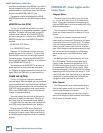
19
Compact Mixer Reference Guide
MIXER ANATOMY: CHAPTER 2
Always be sure to perform the Level-Setting Pro-
cedure when connecting to LINE inputs that have
TRIM controls, and check the level and adjust it
externally on the stereo inputs without TRIMs.
To connect balanced sources to the line-level
inputs, use a 1/4" tip-ring-sleeve (TRS) plug, the type
found on some stereo headphones:
To connect unbalanced line-level sources, use
a cable with 1/4" mono (TS) plugs. In music store
lingo, that’s an “instrument cable” or “quarter inch
patch cord.” When a TS plug is inserted into a TRS
jack, the Ring (low signal) and Sleeve (ground) get
connected together.
See the Mixer Tips section for more information on
balanced and unbalanced connections.
The TRIM Control
The TRIM control adjusts the
input sensitivity of the MIC or LINE
IN jack, to match the input signal
to the operating range of the mixer.
On all Mackie mixing consoles with
the exception of the PPM series,
the TRIM control is located at the top of the channel
strip. That makes it easy to fi nd, since TRIM is the
fi rst control the signal encounters on its way through
the console. The PPM series has an Input Level Set
control and LED indicator above each channel’s
VOLUME control.
Whenever you connect a new input, or the input
source changes (you move the mic from the dulcimer
to the kick drum), you should perform the Level-Set-
ting Procedure. That procedure is “how to use the
TRIM control.”
Connecting Electronic Instruments
Synthesizers, guitar processors, other
electronic instruments, and computer
sound cards work fi ne when connected
to the LINE inputs. The pickups on electric guitars
and basses, even though the plug fi ts, are a different
animal, however. Pickups require a higher input im-
pedance than the Mackie LINE IN provides. Plugging
a guitar into a LINE IN jack will probably make some
sound, but the guitar will lose punch and treble. The
proper way to connect an instrument pickup directly
to a Mackie mixer is to use a Direct Box (or DI =Di-
rect Injection) between the guitar and a MIC input.
Hi-Z Guitar Inputs
After all that, we decided that it
would be a good idea to build a direct in-
strument input into some of our mixers.
On channels 1 and 2 of the Onyx series
mixers and 800R preamp, the MIC/HI-Z
switch switches the channel input from
the XLR mic connector to the 1/4" input
jack. This jack provides a high imped-
ance input suitable for directly connect-
ing an instrument pickup, saving you
the cost and fuss of using a DI. We’re not
stuffy – you can plug your bass in here,
too.
The Hi-Z jack also serves as a line input jack (it
has the same gain as the line inputs on the other
channels). When using line inputs with channels 1
and 2, don’t forget to push the “Guitar” button.
Tape Returns (8-Bus Only)
The TAPE RETURN jacks on the rear panel of the
8-Bus console are for connecting the outputs of a
multitrack recorder.
These are balanced 1/4" TRS jacks which will
also accommodate unbalanced connections. They’re
grouped in sets of eight, with each group having an
OPERATING LEVEL switch to properly match the
gain of these inputs to pro (+4 dBu) or semi-pro
(-10 dBV) recorders.
TAPE RETURN jacks can be routed to either the
channel (for mixing) or Mix-B (during tracking).
Their fate is determined by the FLIP and MIX-B
SOURCE switches.
Tape Inputs
These unbalanced RCA TAPE INPUT jacks are
designed to work with semi-pro as well as pro record-
ers. The provide an unbalanced input at 0 dBu. Con-
nect your 2-track tape recorder’s outputs here, using
standard RCA cables.
SLEEVE
TIPSLEEVE
TIP
RING
RING
TIP
SLEEVERING
TRIM
1
M
I
C
G
A
I
N
060
+15dB -45dB
-
1
0
d
B
V
U
1
O
N
Y
X
M
I
C
P
R
E
GAIN
+40dB
U
-20dB
U
20
30
40
60
HI
-
Z
1
HI
-
Z
MIC
48V
15
13 11 9
16 14 12 10
TAPE RETURNS 9-16
+4 / –10 BALANCED / UNBALANCED
OPERATING
LEVEL CH. 9-16
OUT +4dBu
IN –10dBV
















